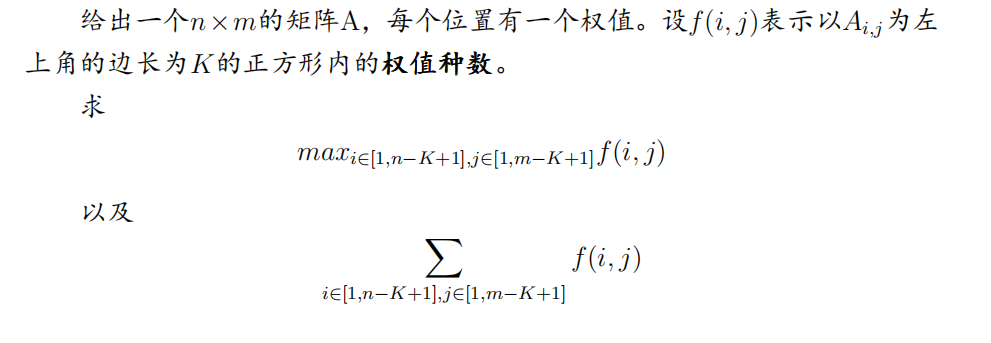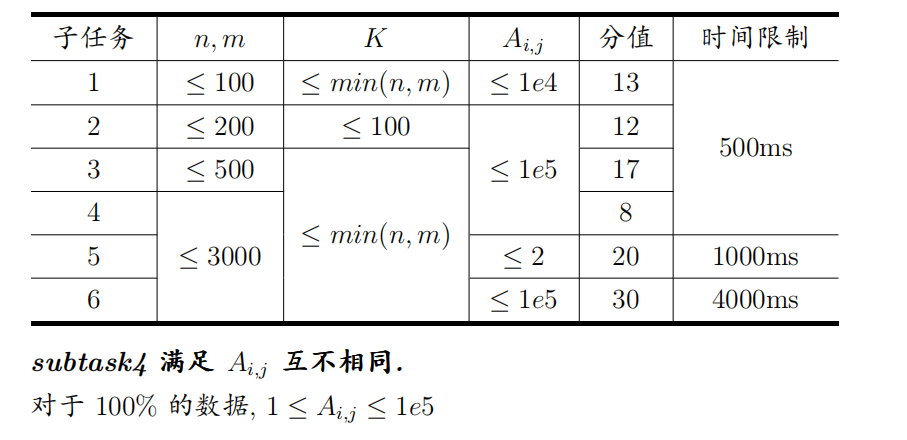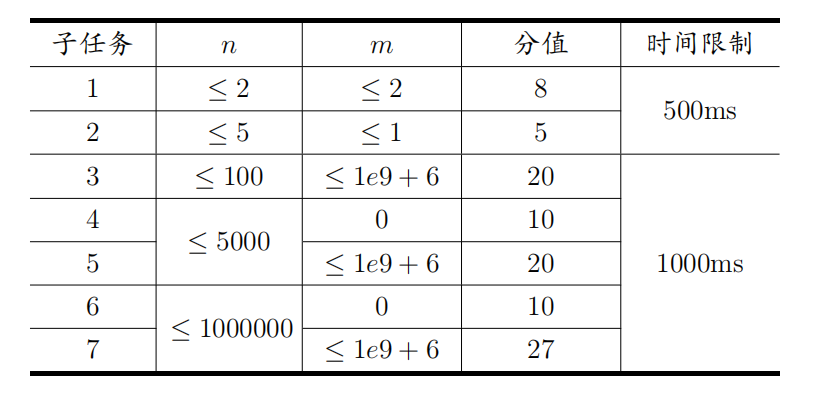19.11.4 summary
Gufen: 100 + 70 + 63
Actual: 100 + 63 + 0
T1

The original title.
First obstacle sorting point, to ensure that the latter point can not come to the front of the point.
Set f [i] indicates the start away from home, after a number of other obstacles to reach the scheme point barrier point i.
Request f [i] when subtracting illegal scheme with the full program.
Obviously, a certain kind of illegal schemes and only one "first hurdle after point"
Therefore, O ( \ (m ^ 2 \) ) transferred just fine.
T2


O (nmK) is clearly
Correct
Consider scanning line, one obtains a line f.
When we added a point, it will affect a square area. However, due to the contribution of the same color point it can not be double-counted, so the actual impact it is an interval. As shown below, only the blue part of the answer ++ just fine. Maintain a differential array.

Delete the situation is similar.
Now we need a support insert, delete, search predecessor successor data structures.
To each point to open a bitset.
Code
#include<cstdio>
#include<cstring>
#include<algorithm>
#include<bitset>
using namespace std;
long long n,m,i,j,k,ans1,ans2,S,bzz;
int sum[3][3005][3005];
int a[3005][3005];
long long delta[3005],f[3005];
bitset<3105> B1[100005],B2[100005];
int g[3005][3005],last[100005];
void does2()
{
for (i=1;i<=n;i++)
for (j=1;j<=m;j++)
{
sum[1][i][j]=sum[1][i-1][j]+sum[1][i][j-1]-sum[1][i-1][j-1]+(a[i][j]==1);
sum[2][i][j]=sum[2][i-1][j]+sum[2][i][j-1]-sum[2][i-1][j-1]+(a[i][j]==2);
}
for (i=1;i<=n-k+1;i++)
{
for (j=1;j<=m-k+1;j++)
{
S=0;
if (sum[1][i+k-1][j+k-1]-sum[1][i-1][j+k-1]-sum[1][i+k-1][j-1]+sum[1][i-1][j-1]>0) S++;
if (sum[2][i+k-1][j+k-1]-sum[2][i-1][j+k-1]-sum[2][i+k-1][j-1]+sum[2][i-1][j-1]>0) S++;
ans1=max(ans1,S);
ans2=ans2+S;
}
}
printf("%lld %lld",ans1,ans2);
}
void getg()
{
for (i=1;i<=100000;i++) last[i]=n+k+1;
for (j=1;j<=m;j++)
{
for (i=n;i>=1;i--)
g[i][j]=(last[a[i][j]]-i<k),last[a[i][j]]=i;
for (i=n;i>=1;i--)
last[a[i][j]]=n+k+1;
}
}
void ADD(long long x,long long y)
{
long long Pre,Nex;
if (B2[a[x][y]][y]) return;
Pre=m-B1[a[x][y]]._Find_next(m-y+1)+1;
Nex=B2[a[x][y]]._Find_next(y);
Nex=Nex-k+1;
B1[a[x][y]][m-y+1]=1;
B2[a[x][y]][y]=1;
if (Nex<=Pre) return;
Pre=max(max(Pre+1,1ll),y-k+1);
Nex=min(min(Nex,m+1),y+1);
if (Nex<=Pre) return;
delta[Pre]++;
delta[Nex]--;
}
void DEL(long long x,long long y)
{
long long Pre,Nex;
if (g[x][y]) return;
Pre=m-B1[a[x][y]]._Find_next(m-y+1)+1;
Nex=B2[a[x][y]]._Find_next(y);
Nex=Nex-k+1;
B1[a[x][y]][m-y+1]=0;
B2[a[x][y]][y]=0;
if (Nex<=Pre) return;
Pre=max(max(Pre+1,1ll),y-k+1);
Nex=min(min(Nex,m+1),y+1);
if (Nex<=Pre) return;
delta[Pre]--;
delta[Nex]++;
}
int main()
{
freopen("read.in","r",stdin);
// freopen("b.out","w",stdout);
scanf("%lld%lld%lld",&n,&m,&k);
bzz=1;
for (i=1;i<=n;i++)
for (j=1;j<=m;j++)
{
scanf("%d",&a[i][j]);
if (a[i][j]>2) bzz=0;
}
if (bzz==1)
{
does2();
return 0;
}
getg();
for (i=1;i<=k-1;i++)
for (j=1;j<=m;j++)
ADD(i,j);
for (i=k;i<=n;i++)
{
for (j=1;j<=m;j++)
ADD(i,j);
for (j=1;j<=m-k+1;j++)
f[j]=f[j-1]+delta[j],ans1=max(ans1,f[j]),ans2+=f[j];
for (j=1;j<=m;j++)
DEL(i-k+1,j);
}
printf("%lld %lld",ans1,ans2);
}T3


O ( \ (n-^. 3 \) ) A method of inverse matrix: the matrix \ (A \) and matrix \ (the I \) together, the \ (A \) eliminating a unit matrix, will change the I to \ (A ^ {- 1} \)
Correct
Find the law found, the answer equal

The difficulty is now seeking the number of combinations and the square \ (\ Sigma_ {i = 0 } ^ {n} (C ^ {i} _ {n}) ^ 2 \)
It is equal to

Code
#include<cstdio>
#include<cstring>
#include<algorithm>
#define mod 1000000007
using namespace std;
long long n,m,i,j,k,L,pick,ans,T,xs,MI,S;
long long jc[3000005],invjc[3000005];
long long mi(long long x,long long y)
{
long long s=1;
while (y>0)
{
if (y%2==1) s=s*x%mod;
x=x*x%mod;
y/=2;
}
return s;
}
long long C(long long a,long long b)
{
return jc[a]*invjc[b]%mod*invjc[a-b]%mod;
}
int main()
{
freopen("read.in","r",stdin);
// freopen("c.out","w",stdout);
jc[0]=1;
for (i=1;i<=3000000;i++)
jc[i]=jc[i-1]*i%mod;
invjc[3000000]=mi(jc[3000000],mod-2);
for (i=3000000-1;i>=0;i--)
{
invjc[i]=invjc[i+1]*(i+1)%mod;
}
scanf("%lld%lld",&n,&m);
for (i=1;i<=n;i++)
{
MI=mi(i,m);
MI=MI*MI%mod;
S=MI*(C(2*i,i)-1)%mod;
ans=(ans+S%mod)%mod;
}
printf("%lld",ans);
return 0;
}